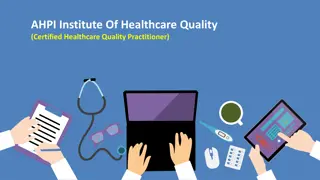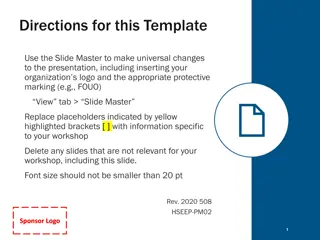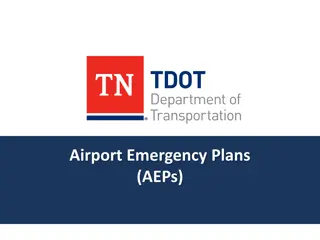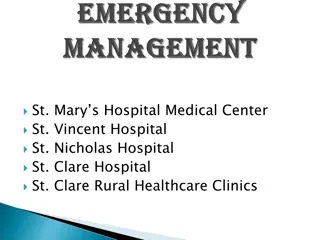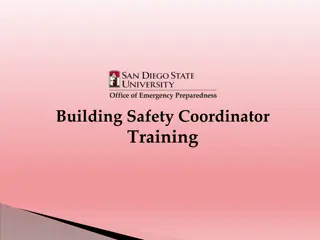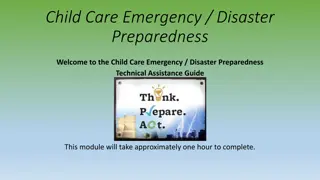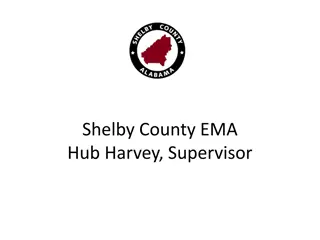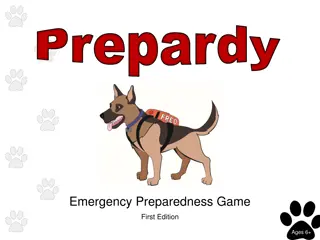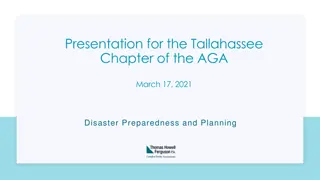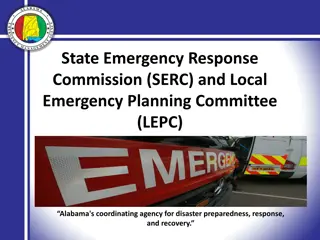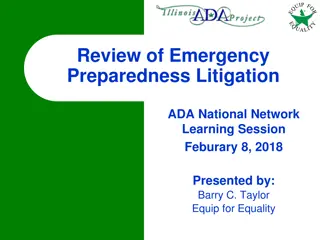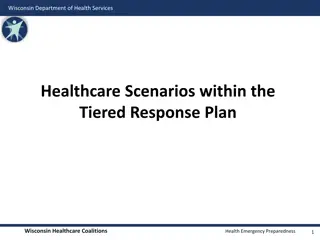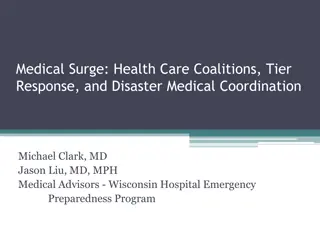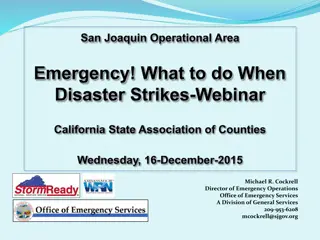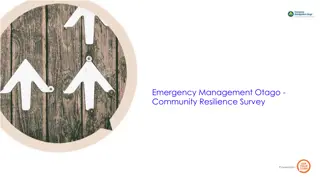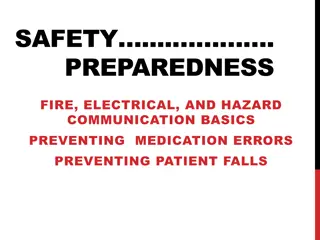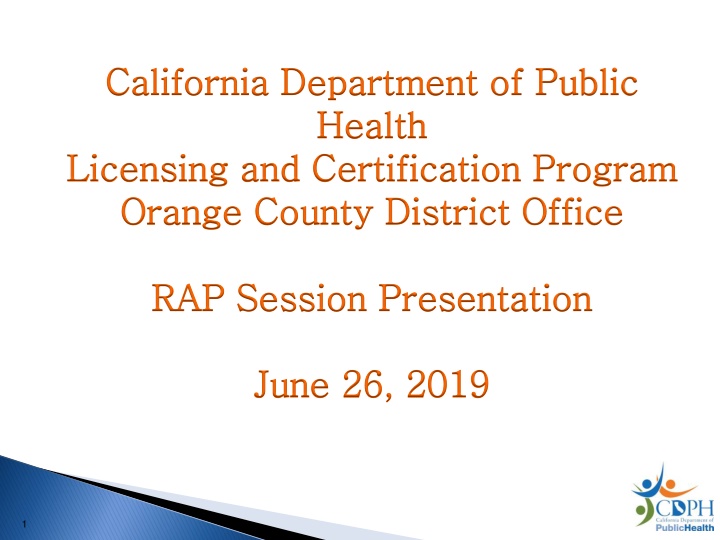
Emergency Preparedness Requirements for Healthcare Facilities in California
Facilities participating in Medicare and Medicaid programs must adhere to emergency preparedness requirements outlined in federal regulations. This presentation emphasizes the importance of developing emergency plans based on risk assessments, utilizing an all-hazards approach to ensure preparedness for a variety of emergencies. It underscores the need to update emergency plans annually and consider specific hazards relevant to the location. The goal is to enhance readiness for potential disasters and emergencies.
Download Presentation

Please find below an Image/Link to download the presentation.
The content on the website is provided AS IS for your information and personal use only. It may not be sold, licensed, or shared on other websites without obtaining consent from the author. If you encounter any issues during the download, it is possible that the publisher has removed the file from their server.
You are allowed to download the files provided on this website for personal or commercial use, subject to the condition that they are used lawfully. All files are the property of their respective owners.
The content on the website is provided AS IS for your information and personal use only. It may not be sold, licensed, or shared on other websites without obtaining consent from the author.
E N D
Presentation Transcript
California Department of Public California Department of Public Health Health Licensing and Certification Program Licensing and Certification Program Orange County District Office Orange County District Office RAP RAP Session Session Presentation Presentation June June 26, 26, 2019 2019 1
Jose Gonzalez Life Safety Code Unit Supervisor
This presentation was prepared as a service to the public and is not intended to grant rights or impose obligations. This presentation may contain references or links to statutes, regulations, or other policy materials. The information provided is only intended to be a general summary. It is not intended to take the place of either the written law or regulations. We encourage readers to review the specific statutes, regulations, and other interpretive materials for a full and accurate statement of contents.
Facilities participating in the Medicare and/or Medicaid Programs are required to meet the Emergency Preparedness Requirements set forth in Title 42 of the Code of Federal Regulations (CFR). Requirements for Long-Term Care (LTC) Facilities: CFR 483.473 Condition of Participation for Intermediate Care Facilities for Individuals with Intellectual Disabilities (ICF/IID): CFR 483.475 These regulations went into effect on November 16, 2016 I Implementation mplementation date date November 15, November 15, 2017 2017
Develop an emergency plan based on a risk assessment. Perform risk assessment using an all- hazards approach, focusing on capacities and capabilities. Update emergency plan at least annually.
An all-hazards approach is an integrated approach to emergency preparedness planning that focuses on capacities and capabilities that are critical to preparedness for a full spectrum of emergencies or disasters, including internal emergencies and a man- made emergency (or both) or natural disaster. This approach is specific to the location of the provider or supplier and considers the particular type of hazards most likely to occur in their areas. These may include, but are not limited to, care equipment and power failures, interruptions in communications, including cyber portion or all of a facility, and interruptions in the normal supply of essentials such as water and food. These may include, related emergencies, but are not limited to, care- -related emergencies, equipment and power failures, interruptions in communications, including cyber- -attacks, loss of a portion or all of a facility, and interruptions in the normal supply of essentials such as water and food. attacks, loss of a
Develop and implement policies and procedures based on the emergency plan and risk assessment. Policies and procedures must address a range of issues including subsistence needs, evacuation plans, procedures for sheltering in place, tracking patients and staff during an emergency. Review and update policies and procedures at least annually.
Develop a communication plan that complies with both Federal and State laws. Coordinate patient care within the facility, across health care providers, and with state and local public health departments and emergency management systems. Review and update plan annually.
Facilities are expected to meet all Training and Testing Requirements by the implementation date (11/15/17). Develop and maintain training and testing programs, including initial training of policies and procedures. Provide training to all staff at least annually and demonstrate knowledge of emergency procedures. Conduct drills and exercises to test the emergency plan.
Participation in a full-scale exercise that is community- based or when a community-based exercise is not accessible, an individual, facility-based exercise. Conduct an additional exercise that may include, but is not limited to the following: o A second full-scale exercise that is individual, facility- based. o A tabletop exercise that includes a group discussion led by a facilitator, using a narrated, clinically-relevant emergency scenario, and a set of problem statements, directed messages, or prepared questions designed to challenge an emergency plan.
Facility approach and facility-based risk assessments, we consider the term facility-based to mean that the emergency preparedness program is specific to the facility. Facility-based includes, but is not limited to, hazards specific to a facility based on the geographic location; Patient/Resident/Client population; facility type and potential surrounding community assets (i.e. rural area versus a large metropolitan area). Facility- -Based Based: : When discussing the terms all-hazards Full agency, multijurisdictional, multi-discipline exercise involving functional (for example, joint field office, emergency operation centers, etc.) and/or boots on the ground response (for example, firefighters decontaminating mock victims). Full- -Scale Exercise: Scale Exercise: A full scale exercise is a multi-
Table a group discussion led by a facilitator, using narrated, clinically-relevant emergency scenario, and a set of problem statements, directed messages, or prepared questions designed to challenge an emergency plan. It involves key personnel discussing simulated scenarios, including computer-simulated exercises, in an informal setting. TTXs can be used to assess plans, policies, and procedures. Table- -top top Exercise (TTX): Exercise (TTX): A table-top exercise is
Providers are encouraged to seek out local state emergency agencies and health care coalitions to participate in a full-scale, community-based exercise. Interpretive Guidelines (IGs) can be found in the CMS website in the State Operations Manual - - Appendix Z The IGs are sub regulatory guidelines which establish our expectations for the function surveyors perform in enforcing the regulatory requirements. Appendix Z - - Emergency Preparedness Emergency Preparedness (latest update 3/4/19) (latest update 3/4/19)
Providers should refer to the resources on the CMS website for assistance in developing emergency preparedness plans. The website also provides important links to additional resources and organizations who can assist. https://www.cms.gov/Medicare/Provider- Enrollment-and- Certification/SurveyCertEmergPrep/index.html
101 17

